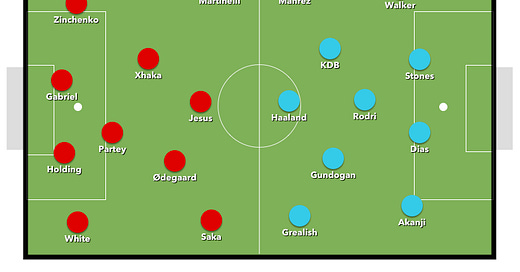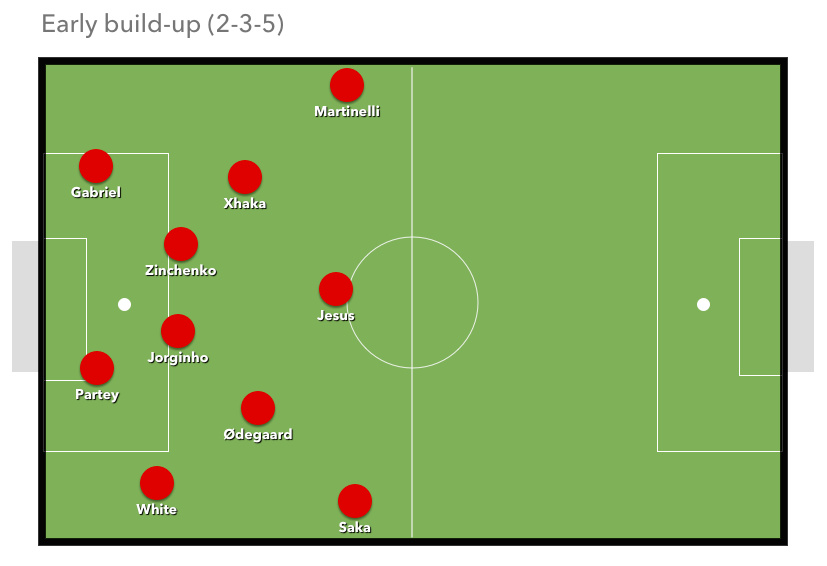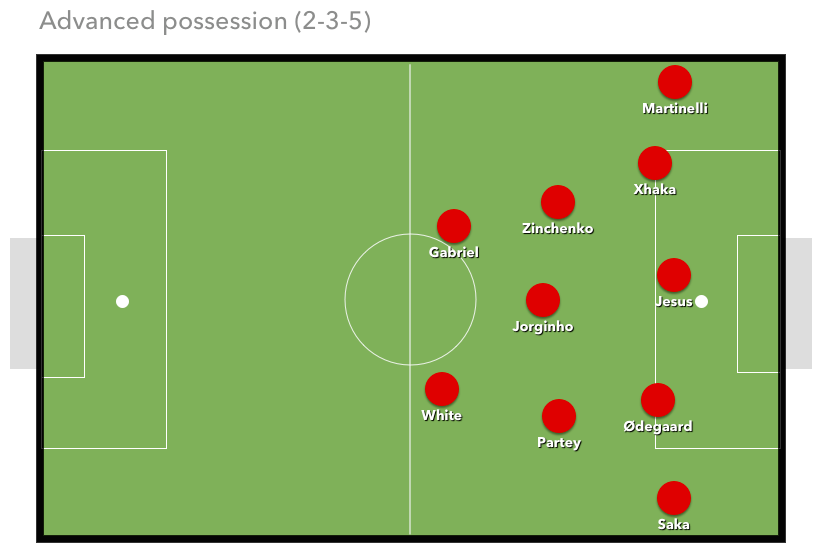Life intervened, and I wasn’t able to get a longer preview done this week, but should be back for a big recap on Friday.
Alas, here are some assorted notes on the game for you to read as you stress-eat. No, I didn’t proofread this, and before you ask, I don’t agree with any of this, either.
So, how are we feeling today?
Choose your fighter:
“Listen to the mustn'ts, child. Listen to the don'ts. Listen to the shouldn'ts, the impossibles, the won'ts. Listen to the never haves, then listen close to me... Anything can happen, child. Anything can be.” ― Shel Silverstein
"Hope is the only universal liar who never loses his reputation for veracity." - Robert G. Ingersoll
This game is fascinating for its own reasons, and I needn’t tell you the stakes.
It will also be fascinating on a tactical level. For large parts of the year, Pep has had his work cut out for him, at least by his standards. Thanks to some ch-ch-changes — including turnover at the full-back position, less speed on the wings, and the installation of a robot striker who would be misused at the false-9 — the team embarked on the long process of sputtering reinvention. Yes, the famed dominance was still largely there, but things felt a little less crisp.
Things changed in early February. That’s the time of their inevitable loss to Tottenham 1-0. Since then, they haven’t lost in any of their 16 games across competitions, scoring 49 and allowing 9, while keeping 7 clean sheets along the way and never allowing an opponent to score multiple goals. There was a four-game stretch where they outscored their opponents 21-2.
What’s changed? Much. In recent weeks, Pep has gone for a centre-back-four. They have looked their best when John Stones joins the box midfield in a hybrid role, forming a nominal double-pivot with Rodri, while allowing Pep to play with four true CB’s.
Along the way, a strange thing has appeared in the stat sheets. In the most pivotal games of their season so far — Arsenal away, the Champions League tie against Bayern — they have willingly ceded possession. The gameplan is somewhat extreme: against Arsenal, they had 123 fewer touches than their previous season low.
They had 37% possession that day — a day they faced a lineup including the likes of Nketiah, Jorginho, and Tomiyasu. Against Bayern, they had 44% and 42%, respectively.
It’s safe to say that Pep has some lessons under his belt. He has been saying, in effect: “I have learnt the hard way that big games are about big moments. My big guys can stop your big moments from going in our net; and my robots can make them happen at a higher level on the other end.” As if to illustrate the point, Ederson hoofed it long rather than playing it out the back against Arsenal.
On the other side, despite form, despite injuries, there are still reasons for hope — and not all of them silly. Playing Man City, the team has been up to the task in the two matchups to date, and on a minute-by-minute basis, has probably been the better team — but Man City has nonetheless captured the Big Moments. Man City is yet to face the likes of Gabriel Jesus this year, and didn’t face Thomas Partey in the last fixture. So it’s a trade of Jesus and Partey for one (1) Saliba. You can decide how that equation works out.
The big things to keep an eye on, as far as I can see it, are:
Who wants the ball? This is not a question you’d expect to ask in an Arteta/Pep matchup this year, but here we are. As we’ve covered, Pep may no longer be quite as fascinated with keeping possession against top opponents. On the other side, the game is at the Etihad, and Arsenal will be missing William Saliba — which has had downstream impacts on build-up and transition defending. There are somewhat compelling cases for a more parked Arsenal than we’ve grown accustomed to. Who is playing out the back? Who is hitting it long?
Haaland vs. Arsenal CB’s: This is one that kept you up last night, so I don’t have to tell you anything. Do you play an aggressive press, forcing Haaland to do some middle-third play, but risking him getting in behind? Or do you deprive him of transitional moments by playing a lower block?
Arsenal wingers vs. Man City’s wide defenders: Nathan Aké is out, and he’s maybe the single player in the world best situated to play Saka 1v1. With that, these wide matchups seem to be in the Arsenal column, particularly when stretching a player like Laporte out into space. Saka may have to do it alone, as the Arsenal right-back (likely White) is probably going to choose his spots carefully to maintain solidity on the other end. How do you manufacture these 1v1’s?
The internet is awash with theories on the best setup for Arsenal. There are some crucial questions of personnel forthcoming, and here’s a quick look at how I’d look at it.
Option 1 — If John Stones plays in a double-pivot
First things first: we’ll cover a few setup possibilities, and many of them still have Rob Holding in them. I feel your look. Some of you are already mad at me.
As we covered before, I believe the true storyline of the last three games has been a little less linear than meets the eye.
Against Liverpool, Holding contributed greatly to the lack of control with his hurried clearances and long-balls; against West Ham, his build-up play was A-OK, though he was targeted relentlessly in transition; against Southampton, again, the mistakes were not his own, and even some of the proximate blame for those mistakes feels flimsy — but he was responsible for giving players space in transition, which compounds problems. In any case, he impacts our buildup, perhaps not quite to the levels that many perceive, but I’m most concerned about whether he can crowd players in transition, and then stick with them.
The story, however, was not about altogether bad performances in the last two weeks: it was about a few massive fuck-ups changing the game: if Ramsdale doesn’t open the game as he did, and Arsenal won 3-0, are we still calling for Holding’s head? It’s the internet, so maybe. But the question is how to scheme a plan that is most likely to result in victory.
This is a Man City set-up that looks to have its cake and eat it too, enabling a double-pivot in the midfield for control (which, as we’ve covered, they no longer deem mandatory) and also four centre-backs to hold fort in the back. If this is the case, I’d look to minimize their advantage in transition, and maximize Arsenal’s. Once they have all four CB’s in the box, they are near-impossible to score against — and this is why they are fundamentally different than playing the likes of Liverpool.
That means I’d open up with a little ConteBall: ceding more possession than usual in a mid-to-low, compact 4-4-2, which morphs into a Contean 5 (and even 6) back early, with Xhaka plugging the space between the left-back (likely Zinchenko) and Gabriel (crowding the KDB happy place), and Partey also playing deep. This is for two reasons: one, Holding is better in settled defending, especially against a threat like Haaland — so let’s pack the box. Two, Pep’s strength and weakness is an obsession with numerical advantage in the final third: if you give him 4, he’ll throw 5. If 5, then 6, and so on. The likes of Conte have exploited that by baiting as many attackers forward and then countering through a hold-up 9.
The trick is to be very intentional and quick with first touches, and not settle for random clearances. I’d funnel low first balls to Jesus, and have him do his best Kane impression, curling outlet balls to Martinelli and Saka in transition, which exploits Arsenal’s biggest qualitative advantage: the wingers 1v1 against the centre-backs in space. Man City is susceptible to getting its aggressive defenders dragged around by false-9’s — Rodri, Dias, and/or Akanji could all potentially get pulled up on Jesus in the above picture — and that can open up space for our boys to look like the Liverpool inverted forwards of the last couple years. Ødegaard can be used in this capacity as well, as we saw in that beautiful Ø-to-Martinelli ball against Brighton.
Depending on how ConteBall you want to go, there can be an argument for Tierney instead of Zinchenko — an argument you will undoubtedly make in the comments — but I think the presence of Xhaka in the defensive half-space is enough of a support system for Zinchenko, and there will still be spells of possession in which Zinchenko is vastly superior.
This is a low-key strength of Arsenal: how many goals have they conceded while facing long, methodical sequences against their settled 4-4-2 this season? The TAA cross probably qualifies, but I struggle to produce a lot of other examples.
As the game moves on, they can continue to induce impatience and move the ball forward, gradually upping the length of sequences and settled possession and taking control of the game back, as Pep throws more and more players forward. I am not pitching an altogether negative setup; just one that is highly practical early in the game.
If Arsenal concedes the lead in this formation, the mandate is clear, and these days, Arteta has more options for chasing a goal late in the game than the opposite.
I don’t necessarily expect this from Arteta. This season, he has always stubbornly tried to impose their core identity on the other team, instead of being reactive. But this is a different kind of game, with different factors in play.
Option 2 — If Kyle Walker starts at right-back
Playing Kyle Walker will likely improve Man City’s transition defending on Martinelli, but sacrifice a little midfield control to do it. With that in mind, I’d simply play the Arsenal game, pressing and possession-wise, with the lineup we saw the last two weeks.
There will be important things to focus on, of course: minimize the mistakes; make Holding intentionally play it right; press high, see what happens. Holding can play physically against Haaland like he did in the FA Cup, and if he needs to be subbed off, we can try other options from there. On the right, White will probably stick back a bit more, and pick his spots for overlaps, so it’ll be great to see as much rotation (underlaps/overlaps) with Saka coming from the likes of Ødegaard and Jesus as possible.
Why this plan? It feels like a long time ago now, but Arsenal already played Man City at the Etihad. While Arsenal’s lineup featured the likes of Nketiah, Tierney, Holding, Tomiyasu, and Vieira, Pep rolled out all his available killers — including Haaland, KDB, Rodri, Aké, Gundogan, Grealish, Mahrez, etc. Everybody save Dias played extensively that day. Even though Holding started, Arsenal played their game — and were the better side while finishing the first half 0-0. The Bad Guys ultimately won 1-0, with Aké scoring in an area defended by Vieira, Tomiyasu, and Sambi.
I’d be willing to run that back with a fuller-strength side and see what happens.
Option 3 — If Xhaka is out
This no longer looks likely, but if Xhaka is indeed out, it’s Trossard left-8 time, and it’s time to play basketball. That front 5 (Martinelli, Trossard, Jesus, Ødegaard, Saka) is legitimately fear-inducing, but the lack of physicality will likely get exploited in set pieces and otherwise. Play fast and try to score 3 or 4.
Option 4 — my preferred Big Brain move
OK, OK, OK. If everybody else gets to pitch their ridiculous schemes, I would like to join in on the fun.
We’ve talked about how, in a positional system, typical role titles can feel obsolete: Jesus is a striker/winger/midfielder, Martinelli is a wingstriker, Zinchenko is a Zinchenko, Stones is a midfielder/centre-back, and so on. When we look at alternate options for the RCB/RB positions, I am most intrigued by looking at the likes of David Alaba, Fernandinho, Stones, and Bayern Toni Kroos to see how those responsibilities may be divvied up to have the best player doing the best possible thing in every moment.
With that, here’s my silly pitch: Jorginho joining as a 6 to help dominate build-up from the back — as we’ve covered, playing against their settled 4 is going to be tough — and White and Partey divvying up the responsibilities of the RB and CB depending on the phase of play.
Out of possession, it would be a low 4-4-2, with Saka helping on the wing (and running a lot, and likely requiring an earlyish sub for Reiss or Trossard). Xhaka drops into the half-space to defend, which allows Martinelli to creep a little bit higher (a la Vinicius), and White will be able to focus his efforts almost entirely on Haaland:
Once the ball is regained, Partey hangs back while everybody else floats out to their positions. The build-up is now controlled by the likes of Gabriel, Partey, Jorginho, Zinchenko, and White. This should be near world-best in terms of intelligence, awareness, and crispness of passing, and can be used to dominate play:
As the play advances, it goes into a 3-2-5, with Zinchenko and Jorginho as a double pivot. While there should be a ridiculous amount of security in this stage, it’s imperative not to lose the ball. Zinchenko and Jorginho are underrated counter-pressers, but their physical limitations mean that it will be impossible for them to disrupt everything that comes their way:
From there, Partey can step up into the midfield three in advanced possession, which will help with a few things: White can hang back as a CB and concentrate on Haaland and Co, and Partey can work on immediate counter-presses to disrupt plays at the source:
There are two sacrifices here: Saka will be less supported (but that support can be generated by others), and the moments where White and Partey are floating into each other’s roles will leave the team vulnerable to a counter.
Ultimately, this is the kind of thing that would be hard to pull off on a short week, and is unlikely to materialize. But in any case: I would feel good about starting with these 11 players and letting the chips fall where they may.
Recently, a nice commenter gave me an unsolicited pep talk about my crutch of self-deprecation. I often write about how I don’t know what I’m talking about, and this time, I got slapped down with a hearty request to tone that shit down, punctuating it with a “know your worth, king.” Good people, all of you.
Some of that is genuinely felt and ingrained in my being, for better or worse; some of it is just trying to be funny. But most of it is an acknowledgement that “to see what is in front of one’s nose needs a constant struggle,” and there’s an odd strain of budding, likely diagnosable megalomania in the tactics discourse that genuinely makes me LOL more than any stand-up.
But in truth, I also don't know if that's always the right frame of mind to see things clearly — any semi-sober analysis should come with a hearty side of "...but I might be wrong." This game is ultimately unknowable, which is what keeps us coming back for more. Throughout this single post, we covered about 10 things that the best minds in the game (Arteta and Pep) have learned this year.
We’re just hours away from this post being outdated; hours away from us all learning a few things, and being proven right or wrong in all kinds of ways.
Anything could happen. What a gift that is.
That's how I feel, at least. I might be wrong.












Know your worth, King
COYG!
Amazing analysis Billy - arguably the most impressive I've ever had the pleasure of reading.